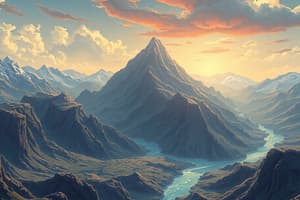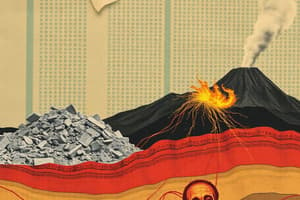Podcast
Questions and Answers
What type of fault occurs due to tension at divergent boundaries?
What type of fault occurs due to tension at divergent boundaries?
- Normal Faults (correct)
- Oblique Faults
- Strike-Slip Faults
- Reverse Faults
Which type of volcano is characterized by steep slopes and explosive eruptions?
Which type of volcano is characterized by steep slopes and explosive eruptions?
- Basalt Volcanoes
- Shield Volcanoes
- Cinder Cone Volcanoes
- Stratovolcanoes (correct)
What geological process is responsible for the formation of fold mountains?
What geological process is responsible for the formation of fold mountains?
- Faulting
- Folding of the crust (correct)
- Subduction
- Erosion
At which type of plate boundary do plates slide past each other, often resulting in earthquakes?
At which type of plate boundary do plates slide past each other, often resulting in earthquakes?
What feature is formed as a result of one plate moving under another at a subduction zone?
What feature is formed as a result of one plate moving under another at a subduction zone?
Which type of volcanic activity occurs at hotspots?
Which type of volcanic activity occurs at hotspots?
What is the primary cause of tsunamis?
What is the primary cause of tsunamis?
Which type of fault is associated with compressional stress at convergent boundaries?
Which type of fault is associated with compressional stress at convergent boundaries?
Which geological feature is created by the divergence of tectonic plates?
Which geological feature is created by the divergence of tectonic plates?
What type of volcanic structure is characterized by being small and steep, formed primarily from ash and lava fragments?
What type of volcanic structure is characterized by being small and steep, formed primarily from ash and lava fragments?
Study Notes
Plate Tectonics Study Notes
Earthquakes and Tectonics
- Earthquakes: Sudden ground movements caused by the release of energy along faults.
- Faults: Fractures in the Earth's crust where blocks of crust slide past each other.
- Types:
- Normal Faults: Occur at divergent boundaries; tension causes extension.
- Reverse Faults: Occur at convergent boundaries; compression causes shortening.
- Strike-Slip Faults: Horizontal movement; occurs at transform boundaries.
- Types:
- Seismic Waves: Energy released during an earthquake travels in waves.
- P-Waves: Primary waves; fastest; can travel through solids and liquids.
- S-Waves: Secondary waves; slower; only travel through solids.
Volcanic Activity
- Volcanoes: Openings in the Earth's surface where magma escapes.
- Types based on eruption style:
- Shield Volcanoes: Gentle slopes; non-explosive eruptions (e.g., Mauna Loa).
- Stratovolcanoes: Steep slopes; explosive eruptions (e.g., Mount St. Helens).
- Cinder Cone Volcanoes: Small, steep; formed from ash and lava fragments.
- Hotspots: Areas of volcanic activity not associated with plate boundaries (e.g., Hawaiian Islands).
Mountain Formation
- Orogeny: The process of mountain formation.
- Caused by tectonic forces:
- Convergent Boundaries: Plates collide, causing uplift (e.g., Himalayas).
- Continental Rifting: Divergence leads to uplift (e.g., East African Rift).
- Types of Mountains:
- Fold Mountains: Formed by the folding of Earth's crust (e.g., Rockies).
- Fault-Block Mountains: Formed by faulting (e.g., Sierra Nevada).
Plate Boundaries
- Divergent Boundaries: Plates move apart, creating new crust (e.g., Mid-Atlantic Ridge).
- Convergent Boundaries: Plates collide, which can lead to subduction (e.g., Andes).
- Transform Boundaries: Plates slide past each other (e.g., San Andreas Fault).
Interactions Along Plate Boundaries and Geological Features
- Subduction Zones: One plate moves under another, leading to volcanic arcs and deep ocean trenches.
- Rift Valleys: Formed at divergent boundaries where the crust is pulled apart (e.g., East African Rift).
- Oceanic Ridges: Underwater mountain ranges formed by divergent boundaries.
- Transform Faults: Lead to earthquakes; often found on land and ocean floors.
Events and Processes
- Tsunamis: Large ocean waves caused by underwater earthquakes or volcanic eruptions.
- Landslides: Ground movement often triggered by earthquakes or volcanic activity.
- Earthquake Measurement:
- Magnitude: Scale of energy released (e.g., Richter scale).
- Intensity: Effects of the earthquake on people and structures (e.g., Mercalli scale).
These notes encapsulate the fundamental concepts of plate tectonics and its associated geological processes and features.
Earthquakes and Tectonics
- Earthquakes result from energy release along faults, leading to sudden ground movement.
- Faults are fractures in the Earth's crust where tectonic blocks slide past one another.
- Normal faults occur at divergent boundaries where tension leads to the extension of crust.
- Reverse faults arise at convergent boundaries, causing compression and shortening.
- Strike-slip faults feature horizontal movement and are found at transform boundaries.
- Seismic waves are the energy released during earthquakes, traveling through the Earth.
- Primary waves (P-waves) are the fastest and can travel through both solids and liquids.
- Secondary waves (S-waves) are slower, only propagating through solids.
Volcanic Activity
- Volcanoes are openings in the Earth's surface that allow magma to escape.
- Shield volcanoes have gentle slopes and erupt non-explosively (e.g., Mauna Loa).
- Stratovolcanoes feature steep slopes and are known for explosive eruptions (e.g., Mount St. Helens).
- Cinder cone volcanoes are small and steep, formed from ash and lava fragments.
- Hotspots provide volcanic activity away from plate boundaries, such as the Hawaiian Islands.
Mountain Formation
- Orogeny refers to the process of mountain building due to tectonic forces.
- Convergent boundaries lead to plate collisions, resulting in uplift (e.g., Himalayas).
- Continental rifting at divergent boundaries also results in uplift (e.g., East African Rift).
- Fold mountains form from the folding of Earth's crust (e.g., Rockies).
- Fault-block mountains arise from faulting processes (e.g., Sierra Nevada).
Plate Boundaries
- Divergent boundaries are characterized by plates moving apart, creating new crust (e.g., Mid-Atlantic Ridge).
- Convergent boundaries involve plates colliding, which can lead to phenomena like subduction (e.g., Andes).
- Transform boundaries occur when plates slide past one another, as seen in the San Andreas Fault.
Interactions Along Plate Boundaries and Geological Features
- Subduction zones lead to the formation of volcanic arcs and deep ocean trenches when one plate moves beneath another.
- Rift valleys form at divergent boundaries due to the pulling apart of the crust (e.g., East African Rift).
- Oceanic ridges are underwater mountain ranges created by divergent boundaries.
- Transform faults are associated with seismic activity, commonly found on land and ocean floors.
Events and Processes
- Tsunamis are large waves generated by underwater earthquakes or volcanic eruptions.
- Landslides are movements of ground material, often triggered by seismic or volcanic activity.
- Earthquake magnitude measures the energy released, commonly evaluated using the Richter scale.
- Earthquake intensity assesses the effects on people and structures, utilizing the Mercalli scale.
Studying That Suits You
Use AI to generate personalized quizzes and flashcards to suit your learning preferences.
Description
Test your knowledge on plate tectonics, earthquakes, and volcanic activity. This quiz covers the types of faults, seismic waves, and different volcanoes. Assess your understanding of these geological concepts through targeted questions.




